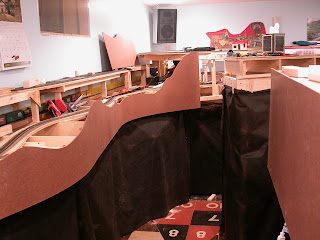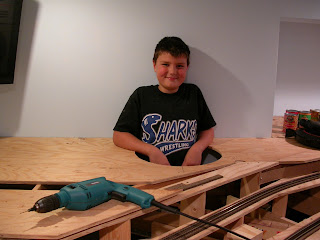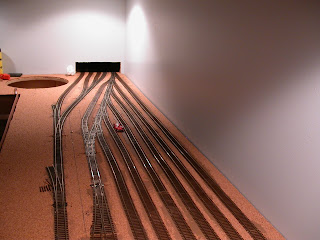
Here's a couple shots of the Durango yard, and engine terminal. Eli has found the turntable pit, as you can see!


Here's the siding at Dolores. This area is also serving at tool storage at the moment, so it's kinda messy. The peninsula with Telluride is on the left, and the line descending from Lizard Head on its way to Rico is on the right, above Dolores. As you can see, Eli has been busy with his toy cars, while the layout is out-of-operation during this phase of construction.

Here's the new wye at Vance Junction; Telluride is up a steep 4% grade beginning at the bottom of the photo. Vance proper is to the left, and the tunnels on the right lead to Ridgway. That's a little of Dolores on the far right, and the staging tracks at McPhee sneaking under the wye. The Christmas-tree lights are hanging from the line to Lizard Head (out-of-view in the upper right-hand corner). The lights are to help me see the McPhee staging once the scenery is in place, in case of derailments or whatever.
 .
. Here's the yard at Telluride, looking back toward Vance Jct. The high-line to Ophir is on the far left.

Here's a couple shots of the Ridgway yard. The wide tunnel in the first show leads to the staging tracks in the bathroom, and the mainline punches thru here on its way to Vance Jct. You can also see the beginnings of the engine termal at Ridgway tucked off on the left side.


In other news, I've run out of track (and money!), so further tracklaying will be on hold for a while. I've just started to work on the fascia at Durango, which is more difficult than the others because of tight clearances at the bottom. At locations like Rico, the bottom edge of the fascia pivots as it drops, because the hinge is a good ways above the bottom edge. This works because the benchwork framing is several inches back here. But at Durango, the benchwork is only about 1" back from the fascia, and there's no room at all for the bottom to pivot in. So, the hinge point needs to be at the very bottom of the fasica. I'm building extra bracing there to support the hinges at the right locations there, and know that I've figured out what to do, the work should be straight-forward (but we'll see!).


